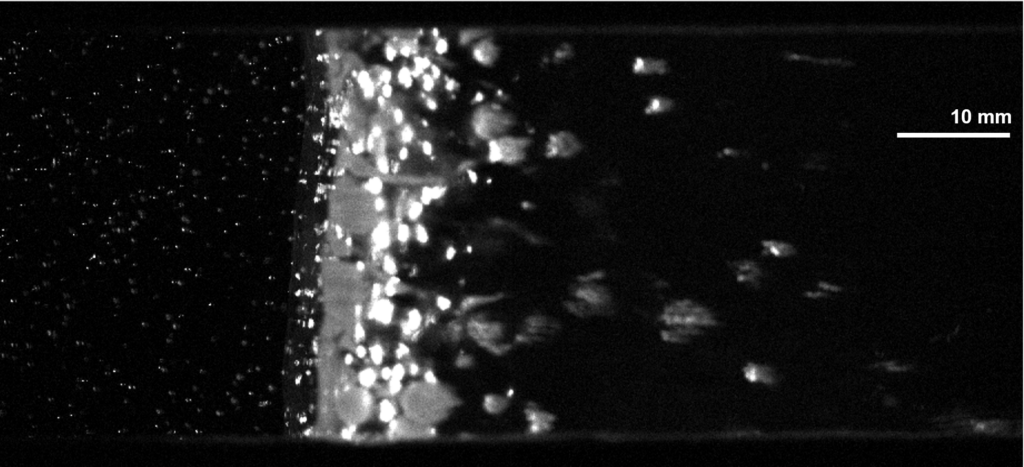Detonation waves are complicated by the presence of liquid or solid fuel particles. Under detonation conditions liquid fuel droplets must breakup, vaporize, and react rapidly. We perform experiments and simulations to develop new models for droplet breakup, evaporation, and reaction under these challenging conditions. Experiments allow us to visualize droplet breakup under these conditions, and to study the resulting detonation properties (e.g. velocity and pressure). Simulations, using the particle in cell method, allow us to understand the motion of droplets and the mixing and reaction of fuel vapor.
Description
In detonation-driven combustion of liquid fuels droplets must breakup, evaporate, and react under extreme (high temperature and pressure) and rapidly changing conditions. This problem involves many interacting physical mechanisms occurring over a wide range of length and time scales. It is a fundamental problem in the development of high-speed, high efficiency flight technologies. For decades, aircraft propulsion has been largely limited to the use of Brayton cycles, with only occasional forays into more advanced technologies for high-speed aircraft such as supersonic combustion (sc)ramjet, and pulse (PDE) and rotating detonation engines (RDE). Detonation engines have the possibility to increase thermal efficiency by 30% over conventional Brayton cycles. These engines can be used for stationary electric power generation and propulsion of aircraft, missiles, and naval vessels including as augmentors, rocket motors, and scramjets. To be practical for propulsion applications, detonation engines must use high-density liquid fuels. Similar challenges are faced in scramjet engines where fuel droplets or particles are processed by shock-expansion wave systems and rapidly reacted . Detonation engines have developed slowly as they require corresponding advances in simulation and experimental capabilities for studying and controlling rapid multiphase mixing and combustion. Advances in gaseous detonation simulation and experimental methods have contributed to the development of gas-fueled RDEs and PDEs, yet liquid-fueled detonations remain challenging to predict and poorly understood. Improving our understanding of droplet breakup and multi-scale mixing in detonations will allow us to overcome the challenges in developing advanced propulsion cycles.
We collaborate on this research with Prof. Praveen Ramaprabhu of the University of North Carolina in Charlotte. Dr. Ramaprabhu’s lab has developed DNS capabilities to resolve droplet breakup and reactions.
Our research in this area has been funded by the Office of Naval Research and the National Science Foundation.
Images
Below is an image of droplets (n-dodecane) undergoing breakup in a detonation (oxygen gas). On the left side are pre-detonation droplet. The shock wave is visible as a vertical distortion in the image. The droplets seem to increase in size as they breakup, but in reality we are seeing a cloud of child droplets stripped from the parent droplet. the droplets then evaporate and react rapidly, causing them to disappear from the image as we travel to the right.

Further Reading
- Tarey, P., Ramaprabhu P., McFarland, J., “Evolution of a shock-impacted reactive liquid fuel droplet with evaporation effects: A numerical study”, J. of Multiphase Flow (2024).
- Young, C., Duke-Walker, V., Agee, S., Ramaprabhu, P., McFarland, J., “Droplet Size Effects in Liquid-Fueled Multiphase Detonations”, AIAA SCITECH (2024)
- Musick, B., Paudel, M., Ramaprabhu, P., McFarland, J., “Numerical Simulations of Droplet Evaporation and Breakup Effects on Heterogeneous Detonations”, Comb. and Flame (2023).
- Musick, B., Manoj P., McFarland, J., “Numerical Study of Fuel Droplet Combustion Under Heterogeneous Detonation
Conditions” 13th United States National Combustion Meeting (2023). - Young, C., Duke-Walker, V., McFarland, J., “Investigations in Multiphase Detonation Phenomena”, 13th U.S. National
Combustion Meeting (2023).
